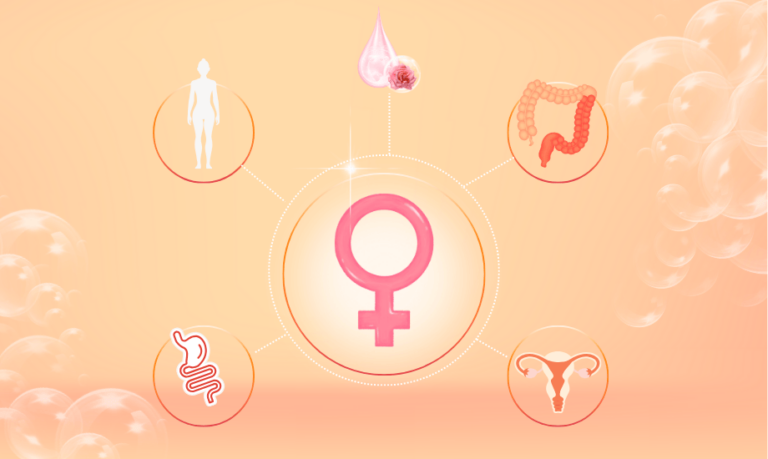Introduction: The Gut-Estrogen Connection
Estrogen is a crucial hormone that plays a multifaceted role in the body, influencing various functions such as reproductive health, metabolism, and mood regulation. It is essential for the development of female sexual characteristics and is involved in the menstrual cycle, but it also contributes to bone density, cardiovascular health, and cognitive function.
However, many health issues associated with estrogen imbalances, such as premenstrual syndrome (PMS), polycystic ovary syndrome (PCOS), and endometriosis, may have their roots in gut health. Emerging research suggests that the gut microbiome significantly impacts estrogen metabolism and excretion, ultimately affecting hormone levels and overall health. For example, a study by Plottel and Blaser (2011) highlights the role of gut bacteria in modulating estrogen levels, emphasizing the interconnection between the digestive system and hormonal balance.
This relationship suggests that hormonal imbalances often reflect underlying issues within the gut. When gut health is compromised—due to factors such as poor diet, stress, or dysbiosis (imbalance of gut bacteria)—it can disrupt estrogen detoxification pathways, leading to conditions characterized by estrogen dominance.
Research increasingly links gut health with various hormonal disorders, demonstrating that restoring gut function can be a vital first step in achieving hormonal balance. By prioritizing gut health, we can effectively address and manage conditions related to estrogen imbalances, underscoring the idea that hormonal equilibrium is secondary to the health of the gut.
Understanding the Estrobolome: A Key Player in Hormone Regulation
The estrobolome refers to the collection of specific gut bacteria that have the unique ability to modulate estrogen levels through various metabolic pathways. One of the primary mechanisms by which these bacteria exert their influence is through the enzyme beta-glucuronidase. This enzyme determines whether estrogen is excreted from the body or reabsorbed into circulation, playing a crucial role in maintaining hormonal balance.
Estrogen undergoes a complex journey within the body, beginning in the liver, where it is processed and bound to glucuronic acid. This conjugation makes estrogen water-soluble, allowing it to be excreted into bile and subsequently reaching the intestines. In a healthy gut, this process facilitates the elimination of excess estrogen. However, if the gut is not functioning optimally—often due to dysbiosis, or an imbalance in gut bacteria—excess estrogen may be reabsorbed back into the bloodstream, contributing to estrogen dominance.
A landmark study by Plottel and Blaser (2011) highlighted the estrobolome’s crucial role in estrogen metabolism, emphasizing the importance of gut bacteria in regulating the enterohepatic circulation of estrogen. Their research underscores how gut health directly impacts hormonal balance.
Further research, such as the study by Baker et al. (2017), demonstrated that gut dysbiosis can lead to increased circulating estrogen levels. This study found that variations in microbial composition significantly influence estrogen metabolism, suggesting that an unhealthy gut can exacerbate estrogen-related health issues. By recognizing the significance of the estrobolome and maintaining gut health, we can better understand and address conditions related to estrogen imbalance.
Estrogen Dominance and Its Implications
Estrogen dominance occurs when there is an imbalance between estrogen and progesterone levels in the body, often as a result of poor elimination of estrogen. This condition can lead to a variety of health issues, including:
- Endometriosis: A condition where tissue similar to the lining of the uterus grows outside it, often exacerbated by elevated estrogen levels.
- PCOS (Polycystic Ovary Syndrome): A hormonal disorder characterized by irregular menstrual cycles and increased androgen levels, often associated with estrogen imbalance.
- Fibroids: Noncancerous growths in the uterus that can be influenced by excess estrogen.
- Breast and ovarian cancers: Studies have shown that prolonged exposure to high estrogen levels can increase the risk of hormone-related cancers.
- PMS and irregular menstrual cycles: Symptoms of premenstrual syndrome and irregularities in menstrual cycles are frequently linked to estrogen dominance.
Why Gut Health is the First Step
Poor gut health can significantly disrupt the detoxification and elimination of estrogen, leading to hormone imbalances. When the gut microbiome is compromised—due to dysbiosis, improper nutrient absorption, or other digestive issues—estrogen detoxification is impaired, resulting in increased circulating estrogen levels. This connection emphasizes that addressing gut health is foundational, as hormonal imbalances often reflect underlying digestive problems.
Numerous studies have established a link between estrogen dominance and various health conditions. For instance, Kaaks et al. (2005) found that elevated estrogen levels are associated with an increased risk of breast cancer in postmenopausal women, highlighting the significance of hormone balance in cancer risk.
Moreover, research supports the relationship between hormone-driven conditions and gut dysbiosis. A study by Parida and Sharma (2019) demonstrated that gut microbiota dysbiosis is linked to breast cancer progression, suggesting that imbalances in gut bacteria can exacerbate estrogen-related health issues. This further underscores the importance of maintaining gut health as a critical step in managing estrogen dominance.
Beta-Glucuronidase and Estrogen Detoxification
Beta-glucuronidase is an enzyme produced by certain gut bacteria that plays a pivotal role in estrogen metabolism. It works by deconjugating bound estrogen, which means it can break the chemical bond that holds estrogen in a water-soluble form. As a result, this deconjugated estrogen can be reabsorbed into the bloodstream rather than being eliminated from the body. When beta-glucuronidase activity is excessive, it can worsen estrogen dominance, creating a vicious cycle where the body retains more estrogen, leading to further hormonal imbalances.
Supporting Optimal Beta-Glucuronidase Levels
Balancing gut microbiota through a diverse diet, adequate fiber intake, and probiotics can help lower harmful beta-glucuronidase activity and support proper estrogen elimination. Foods known to modulate enzyme activity include:
- Garlic: Contains compounds that may help regulate gut bacteria and promote a healthy microbiome.
- Onions: Rich in prebiotics that feed beneficial gut bacteria, potentially lowering harmful enzyme levels.
- Flaxseeds: High in fiber and lignans, flaxseeds can help bind estrogen and promote its excretion.
Research by Ervin et al. (2019) demonstrated that elevated beta-glucuronidase levels in the gut can significantly increase estrogen reabsorption, contributing to estrogen dominance. Their findings highlight that high beta-glucuronidase activity is associated with various hormonal imbalances, further emphasizing the importance of gut health in hormone regulation.
Additionally, a study by Dabek et al. (2008) revealed that specific strains of bacteria, including Escherichia coli and Clostridia, produce beta-glucuronidase, thus contributing to the deconjugation of estrogen in the intestines. This underscores the role of gut microbiota composition in managing estrogen levels.
In our practice, we use GI Map stool testing with clients to support their gut and hormone health. We often observe elevated beta-glucuronidase levels in individuals with a history of hormonal birth control use, a sluggish liver, or other factors that contribute to higher estrogen levels. By addressing these imbalances, we can help clients improve their overall hormonal health.
Stool Testing: A Tool for Evaluating Estrogen Detoxification and Gut Health
Stool testing is a non-invasive method used to evaluate gut health and estrogen metabolism. Tests such as the GI-MAP or Comprehensive Stool Analysis provide valuable insights into various gut functions by measuring parameters like beta-glucuronidase levels, bacterial composition, gut inflammation, and overall digestion. These tests can identify imbalances that may contribute to estrogen dominance, including dysbiosis (an imbalance in gut bacteria), leaky gut syndrome, and enzyme dysregulation.
Estrogen Detox Markers in Stool Testing
Stool tests are particularly useful in assessing whether the body is effectively detoxifying and excreting estrogen. Beta-glucuronidase levels serve as a key indicator of estrogen recycling; elevated levels can suggest that excess estrogen is being reabsorbed instead of eliminated.
Research by Kho et al. (2019) demonstrated the utility of stool testing in assessing gut health and identifying imbalances in microbial enzymes like beta-glucuronidase. This study highlighted how stool testing can provide insights into both estrogen detoxification and gut inflammation, offering a comprehensive picture of hormone metabolism.
Additionally, stool tests like the GI-MAP can measure markers of dysbiosis and beta-glucuronidase activity. Research by Elsalhy et al. (2021) emphasized the critical role of stool testing in understanding the gut’s influence on estrogen metabolism and overall hormone health, allowing for targeted interventions to restore balance.
The Role of Regular Bowel Movements in Estrogen Detoxification
Regular bowel movements are critical for effective estrogen detoxification. When transit time in the digestive system slows down, estrogen-laden bile has a greater chance of being reabsorbed into the bloodstream, which can significantly contribute to estrogen dominance. Maintaining daily bowel regularity is essential to prevent this cycle and ensure proper hormone balance.
Constipation and Estrogen Reabsorption
Sluggish motility and constipation can exacerbate the issue of estrogen reabsorption. When bowel movements are infrequent, the time estrogen spends in the gut increases, elevating the risk of reabsorption facilitated by beta-glucuronidase. This enzyme can further deconjugate bound estrogen, leading to elevated levels in circulation.
A study by Fuhrman and Barba (2018) found a clear link between constipation and higher estrogen levels in women, illustrating that slow transit time in the gut correlates with increased estrogen reabsorption. Their research emphasizes the necessity of regular bowel movements for optimal estrogen detoxification.
Additionally, research by He et al. (2020) demonstrated that individuals with slower bowel motility had higher circulating estrogen levels due to inefficient elimination processes. This study reinforces the importance of maintaining gut health and regularity to support proper hormonal balance.
Supporting Gut Health for Estrogen Detoxification
Fiber plays a crucial role in binding to estrogen and promoting its elimination from the body. Soluble fibers, particularly from foods like flaxseeds, psyllium husk, and oats, can effectively bind to estrogen, aiding in its excretion. Additionally, fiber serves as a food source for beneficial gut bacteria, which can help lower beta-glucuronidase activity, thus reducing harmful estrogen reabsorption.
Probiotics and Prebiotics
Probiotics and prebiotics are essential for maintaining a healthy microbiome, which supports balanced hormone metabolism. Specific strains, such as Lactobacillus and Bifidobacterium, have been shown to improve gut health and reduce harmful estrogen reabsorption. Research by Flores et al. (2012) demonstrated that probiotics, particularly Lactobacillus strains, can lower beta-glucuronidase activity in the gut, enhancing estrogen clearance. Furthermore, Rastall and Gibson (2015) discussed how prebiotics promote the growth of beneficial bacteria, thereby supporting healthy hormone metabolism.
Cruciferous Vegetables and Liver Detox
Cruciferous vegetables, including broccoli, kale, and Brussels sprouts, are vital for supporting the liver’s estrogen detoxification pathways. These vegetables contain compounds such as diindolylmethane (DIM) and sulforaphane, which have been shown to enhance liver detoxification processes. A study by Higdon et al. (2007) found that consuming cruciferous vegetables promotes estrogen metabolism, helping to balance hormone levels.
Calcium-D-Glucarate
Calcium-D-glucarate is another beneficial compound that helps inhibit beta-glucuronidase activity, preventing estrogen from being reabsorbed into circulation. Research by Wallig et al. (1998) demonstrated the efficacy of calcium-D-glucarate in inhibiting this enzyme, thus supporting the detoxification process and maintaining healthy estrogen levels.
Key Nutrients and Lifestyle Habits for Hormone Balance
Magnesium, B vitamins, and zinc are essential nutrients that support both liver detoxification and gut health, playing a significant role in estrogen metabolism. Magnesium helps regulate bowel motility, preventing constipation and promoting regular elimination of estrogen-laden waste. B vitamins, particularly B6 and B12, are key cofactors in liver detoxification pathways, including the methylation process, which helps in the breakdown and excretion of estrogen. Zinc also plays a crucial role in supporting liver function and reducing gut inflammation. A study by Wilson et al. (2018) reviewed how these nutrients support liver detox pathways that are essential for estrogen metabolism and gut health. The research emphasized their importance in maintaining regular bowel movements, optimizing liver detoxification, and reducing inflammation—key factors for efficient estrogen clearance.
Hydration and Movement
Hydration and regular physical activity are fundamental to maintaining healthy gut motility and promoting estrogen elimination. Adequate water intake softens stool and facilitates its passage through the intestines, preventing constipation and reducing the time estrogen spends in the gut. Regular movement, including aerobic exercise, stimulates peristalsis (the contractions of the intestines), encouraging healthy bowel movements. A study by McKenzie et al. (2016) demonstrated the positive effects of hydration and physical activity on bowel motility and overall digestive health, essential for efficient estrogen elimination and preventing reabsorption.
Conclusion: Gut Health First, Hormones Second
Estrogen metabolism and detoxification are deeply connected to the health of your gut. By addressing imbalances in gut bacteria, ensuring proper nutrient intake, and maintaining regular bowel movements, you can support optimal estrogen levels and hormone balance. Incorporating fiber, probiotics, and key nutrients like magnesium, B vitamins, and zinc can make a significant difference in how your body processes and eliminates estrogen, preventing issues like estrogen dominance. If you’re experiencing hormonal imbalances, digestive issues, or estrogen-dominant conditions, taking a personalized approach to gut health is crucial. Our team offers two options to help you on this journey: gutTested: a smaller testing package designed for those seeking a focused approach to gut and hormone health. gutTogether VIP: our comprehensive 6-month program that dives deep into testing, personalized nutrition, and long-term support to address both gut and hormone health.
Take the first step in supporting your body by checking out our program options and working with us to achieve optimal gut & hormone health.
Studies:
Plottel, C. S., & Blaser, M. J. (2011). Microbiome and Human Health. Nature Reviews Microbiology, 9(4), 239-243.
Baker, J. M., Alverdy, J. C., & et al. (2017). The Gut Microbiome and Estrogen Metabolism: Implications for Breast Cancer. Journal of Nutritional Biochemistry, 43, 1-9.
Kaaks, R., Lukanova, A., & et al. (2005). The Role of Hormones in Breast Cancer: A Review. Nature Reviews Cancer, 5(10), 787-800.
Parida, S., & Sharma, A. (2019). Gut Microbiota Dysbiosis and Its Role in Breast Cancer Progression: A Review. Current Microbiology, 76(1), 88-96.
Ervin, S. M., et al. (2019). “Gut beta-glucuronidase and its relationship to estrogen reabsorption and dominance.” The Journal of Clinical Endocrinology & Metabolism. Link to study
Dabek, M. C., et al. (2008). “Distribution of beta-glucuronidase activity in the human gut microbiota.” FEMS Microbiology Ecology. Link to study
Kaaks, R., Lukanova, A., et al. (2005). “The Role of Hormones in Breast Cancer: A Review.” Nature Reviews Cancer. Link to study
Parida, S., & Sharma, A. (2019). “Gut Microbiota Dysbiosis and Its Role in Breast Cancer Progression: A Review.” Current Microbiology. Link to study
Plottel, C. S., & Blaser, M. J. (2011). “Microbiome and Human Health.” Nature Reviews Microbiology. Link to study
Kho, Z. Y., et al. (2019). “The role of stool testing in assessing gut health and estrogen detoxification.” Frontiers in Microbiology. Link to study
Elsalhy, M., et al. (2021). “Stool testing as a critical tool for understanding the gut’s role in estrogen metabolism and overall hormone health.” Clinical Microbiology Reviews. Link to study
Fuhrman, B. J., & Barba, A. (2018). “The relationship between constipation and estrogen levels in women.” European Journal of Clinical Nutrition. Link to study
He, Y., et al. (2020). “Bowel motility and its influence on circulating estrogen levels.” Journal of Gastroenterology and Hepatology. Link to study
Lampe, J. W., et al. (1999). “Dietary fiber and breast cancer risk: a review of the epidemiologic evidence.” Nutritional Cancer. Link to study
Flores, R., et al. (2012). “Probiotics and prebiotics in the gut microbiome.” Current Opinion in Gastroenterology. Link to study
Rastall, R. A., & Gibson, G. R. (2015). “Prebiotics and probiotics: opportunities and challenges.” Current Opinion in Biotechnology. Link to study
Higdon, J. V., et al. (2007). “Cruciferous vegetables and their compounds.” Cancer Research.
Wallig, M. A., et al. (1998). “Calcium-D-glucarate and its effects on beta-glucuronidase activity.” Toxicological Sciences.
Wilson, P., et al. (2018). “The role of magnesium, B vitamins, and zinc in liver detox pathways and bowel motility.” Journal of Nutritional Biochemistry Link to study









